parking brake BUICK REGAL 1998 Owners Manual
[x] Cancel search | Manufacturer: BUICK, Model Year: 1998, Model line: REGAL, Model: BUICK REGAL 1998Pages: 388, PDF Size: 20.19 MB
Page 75 of 388
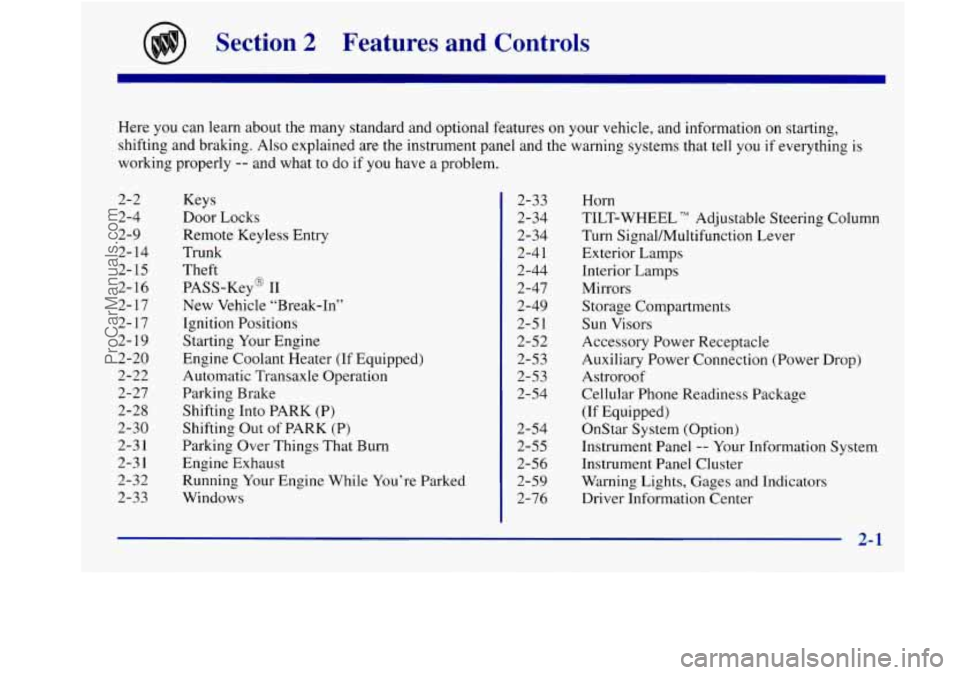
Section 2 Features and Controls
Here you can learn about the many standard and optional features on your vehicle, and information on starting,
shifting and bralung. Also explained are the instrument panel and the warning systems that tell you
if everything is
working properly
-- and what to do if you have a problem.
2-2
2-4
2-9
2- 14
2- 15
2- 16
2- 17
2-1 7
2- 19
2-20
2-22
2-27
2-28
2-30
2-3 1
2-3 1
2-32
2-33 Keys
Door Locks
Remote Keyless Entry
Trunk
Theft
PASS-Key@ I1
New Vehicle “Break-In”
Ignition Positions Starting Your Engine
Engine Coolant Heater (If Equipped)
Automatic Transaxle Operation
Parking Brake
Shifting Into PARK (P)
Shifting
Out of PARK (P)
Parking Over Things That Burn
Engine Exhaust Running Your Engine While You’re Parked
Windows 2-33
2-34
2-34
2-4 1
2-44
2-47
2-49
2-5 1
2-52
2-53
2-53
2-54
2-54
2-55
2-56
2-59
2-76 Horn
TILT-WHEEL
TM Adjustable Steering Column
Turn Signal/Multifunction Lever
Exterior Lamps
Interior Lamps
Mirrors
Storage Compartments
Sun Visors
Accessory Power Receptacle
Auxiliary Power Connection (Power Drop)
Astroroof
Cellular Phone Readiness Package
(If Equipped)
OnStar System (Option)
Instrument Panel
-- Your Information System
Instrument Panel Cluster
Warning Lights, Gages and Indicators
Driver Information Center
2-1
ProCarManuals.com
Page 97 of 388
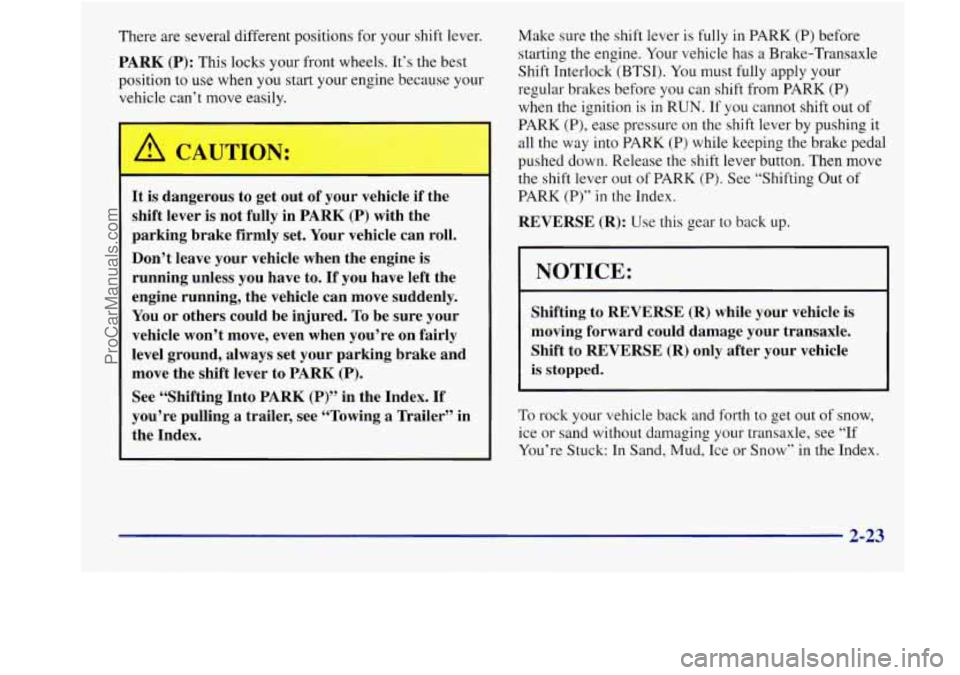
There are several different positions for your shift lever.
PARK
(P): This locks your front wheels. It’s the best
position to use when you start your engine because your
vehicle can’t move easily.
r
It is dangerous to get out of your vehicle if the
shift lever is not fully in PARK
(P) with the
parking brake firmly set. Your vehicle can roll.
Don’t leave your vehicle when the engine is
running unless you have to.
If you have left the
engine running, the vehicle can move suddenly.
You or others could be injured.
To be sure your
vehicle won’t move, even when you’re on fairly
level ground, always set your parking brake and
move the shift lever to PARK
(P).
See “Shifting Into PARK (P)” in the Index. If
you’re pulling
a trailer, see “Towing a Trailer” in
the Index. Make sure
the shift lever is
fully in PARK (P) before
starting the engine. Your vehicle has
a Brake-Transaxle
Shift Interlock
(BTSI). You must fully apply your
regular brakes before you can shift from PARK (P)
when the ignition is in RUN. If you cannot shift out
of
PARK (P), ease pressure on the shift lever by pushing it
all the way into PARK (P) while keeping the brake pedal
pushed down. Release the shift lever button. Then move
the shift lever out
of PARK (P). See “Shifting Out of
PARK (P)”
in the Index.
REVERSE (R): Use this gear to back up.
NOTICE:
Shifting to REVERSE (R) while your vehicle is
moving forward could damage your transaxle.
Shift
to REVERSE (R) only after your vehicle
is
stopped.
To rock your vehicle back and forth to get out of snow,
ice or sand without damaging your transaxle, see “If
You’re Stuck: In Sand, Mud, Ice or Snow” in the Index.
2-23
ProCarManuals.com
Page 101 of 388
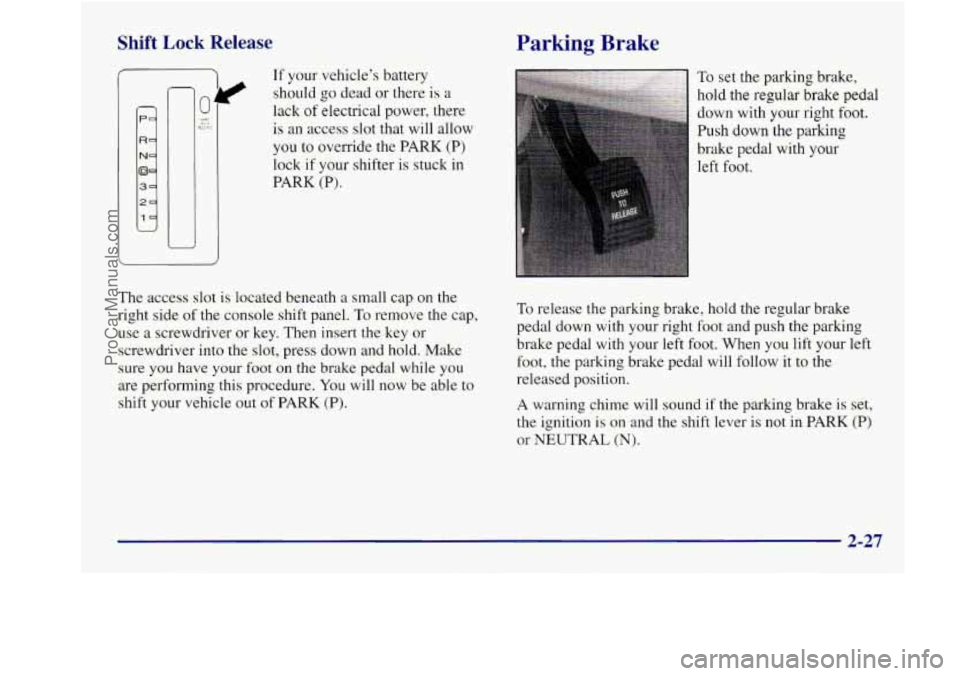
Shift Lock Release Parking Brake
P
1 2
If your vehicle’s battery
should
go dead or there is a
lack of electrical power, there
is an access slot that will allov
you
to override the PARK (P)
lock if your shifter is stuck
in
PARK (P).
J
To set the parking brake,
hold the regular brake pedal
down with your right foot.
Push down the parking
brake pedal with your
left foot.
The access slot is located beneath
a small cap on the
right side of the console shift panel.
To remove the cap,
use
a screwdriver or key. Then insert the key or
screwdriver into the slot, press down and hold. Make
sure you have your foot
on the brake pedal while you
are performing this procedure. You will now be able to
shift your vehicle out of PARK (P).
To release the parking brake, hold the regular brake
pedal down with your right foot and push the parking
brake pedal with your left foot. When
you lift your left
foot,
the parking brake pedal will follow it to the
released position.
A warning chime will sound if the parking brake is set,
the ignition
is on and the shift lever is not in PARK (P)
or NEUTRAL (N).
2-27
ProCarManuals.com
Page 102 of 388
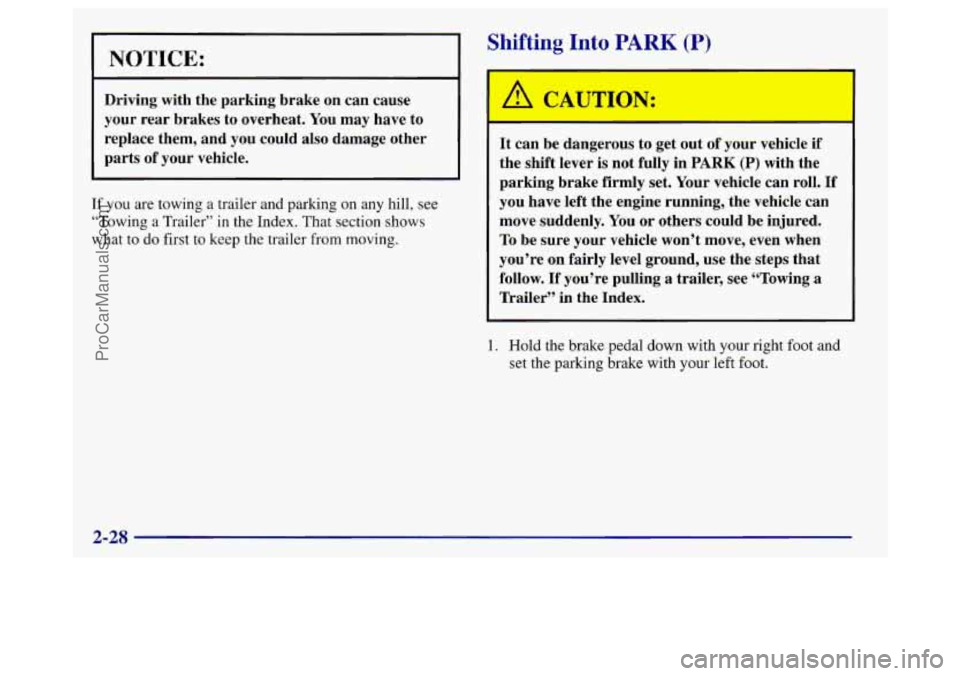
NOTICE:
Driving with the parking brake on can cause
your rear brakes to overheat. You may have to
replace them, and you could also damage other
parts of your vehicle.
If you are towing a trailer and parking on any hill, see
“Towing a Trailer” in the Index. That section shows
what to do first to keep the trailer from moving.
Shifting Into PARK (P)
1. Hold the brake pedal down with your right foot and
set the parking brake with your left foot.
-
It can be dangerous to get out of your vehicle if ’
the shift lever is not fully in PARK (P) with the
parking brake firmly set, Your vehicle can roll,
If
you have left the engine running, the vehicle can
move suddenly. You or others could be injured.
To be sure your vehicle won’t move, even when
you’re on fairly level ground, use the steps that
follow. If you’re pulling
a trailer, see ‘(Towing a
Trailer” in the Index.
2-28
ProCarManuals.com
Page 103 of 388
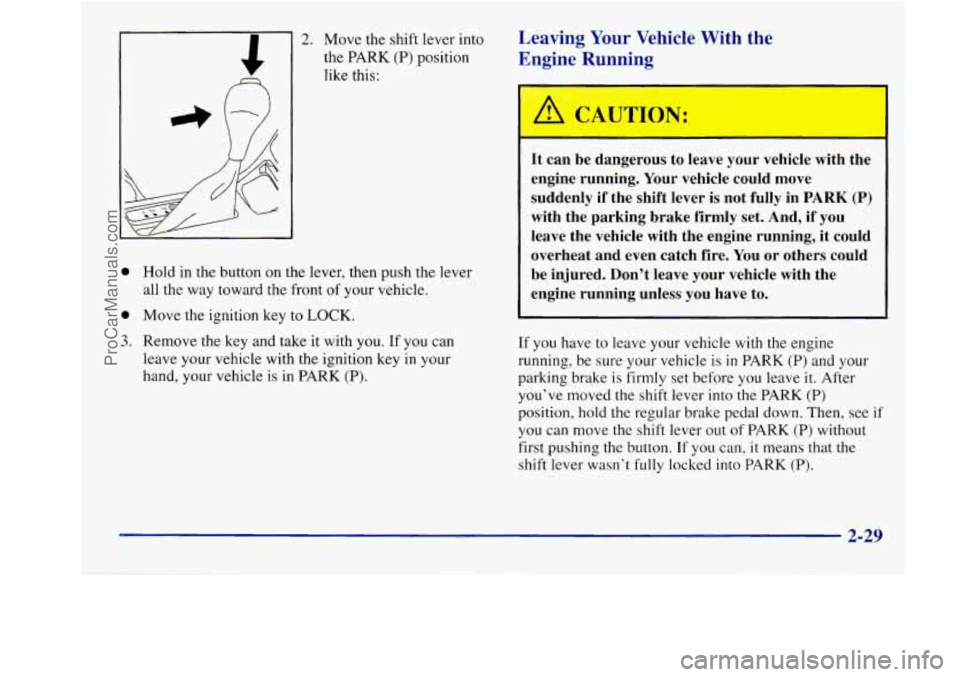
2. Move the shift lever into
the PARK
(P) position
like this:
0 Hold in the button on the lever, then push the lever
all the way toward the front
of your vehicle.
0 Move the ignition key to LOCK.
3. Remove the key and take it with you. If you can
leave your vehicle with the ignition key in your
hand, your vehicle is in PARK
(P).
Leaving Your Vehicle With the
Engine Running
It can be dangerous to leave your vehicle with the
engine running. Your vehicle could move
suddenly if the shift lever is not fully
in PARK (P)
with the parking brake firmly set. And, if you
leave the vehicle with the engine running, it could
overheat and even catch fire. You
or others could
be injured. Don’t leave your vehicle with the
engine running unless
you have to.
.~
If you have to leave your vehicle with the engine
running, be sure your
vehicle is in PARK (P) and your
parking brake is firmly set before
you leave it. After
you’ve moved the shift lever into the PARK
(P)
position, hold the regular brake pedal down. Then, see if
you can move the shift lever out
of PARK (P) without
first pushing the button. If you can, it means that the
shift lever wasn’t
fully locked into PARK (P).
2-29
ProCarManuals.com
Page 104 of 388
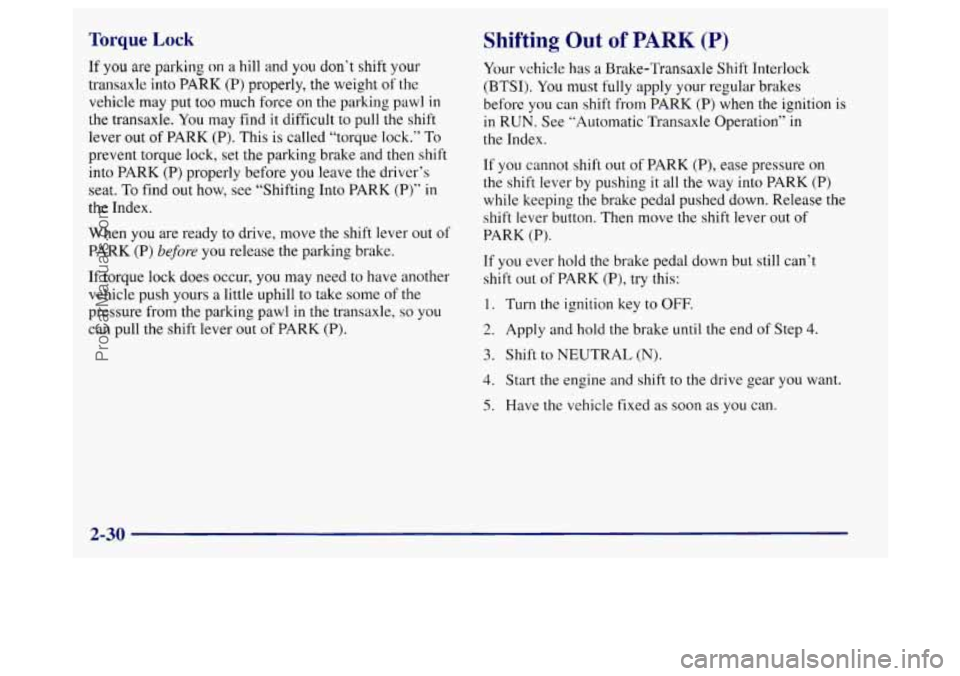
Torque Lock
If you are parking on a hill and you don’t shift your
transaxle into
PARK (P) properly, the weight of the
vehicle may put too much force on the parking pawl
in
the transaxle. You may find it difficult to pull the shift
lever out of PARK (P). This is called “torque lock.” To
prevent torque lock, set the parking brake and then shift
into PARK (P) properly before
you leave the driver’s
seat. To find out how, see “Shifting Into PARK
(P)” in
the Index.
When you are ready to drive, move the shift lever out of
PARK (P)
before you release the parking brake.
If torque lock does occur, you may need
to have another
vehicle push yours
a little uphill to take some of the
pressure from the parking pawl in the transaxle, so you
can pull the shift lever out of PARK (P).
Shifting Out of PARK (P)
Your vehicle has a Brake-Transaxle Shift Interlock
(BTSI).
You must fully apply your regular brakes
before you can shift from PARK
(P) when the ignition is
in RUN. See “Automatic Transaxle Operation” in
the Index.
If you cannot shift out
of PARK (P), ease pressure on
the shift lever by pushing it all the way into PARK
(P)
while keeping the brake pedal pushed down. Release the
shift lever button. Then move the shift lever out of
PARK
(P).
If you ever hold the brake pedal down but still can’t
shift out of PARK
(P), try this:
1. Turn the ignition key to OFF.
2. Apply and hold the brake until the end of Step 4.
3. Shift to NEUTRAL (N).
4. Start the engine and shift to the drive gear you want.
5. Have the vehicle fixed as soon as you can.
2-30
ProCarManuals.com
Page 106 of 388
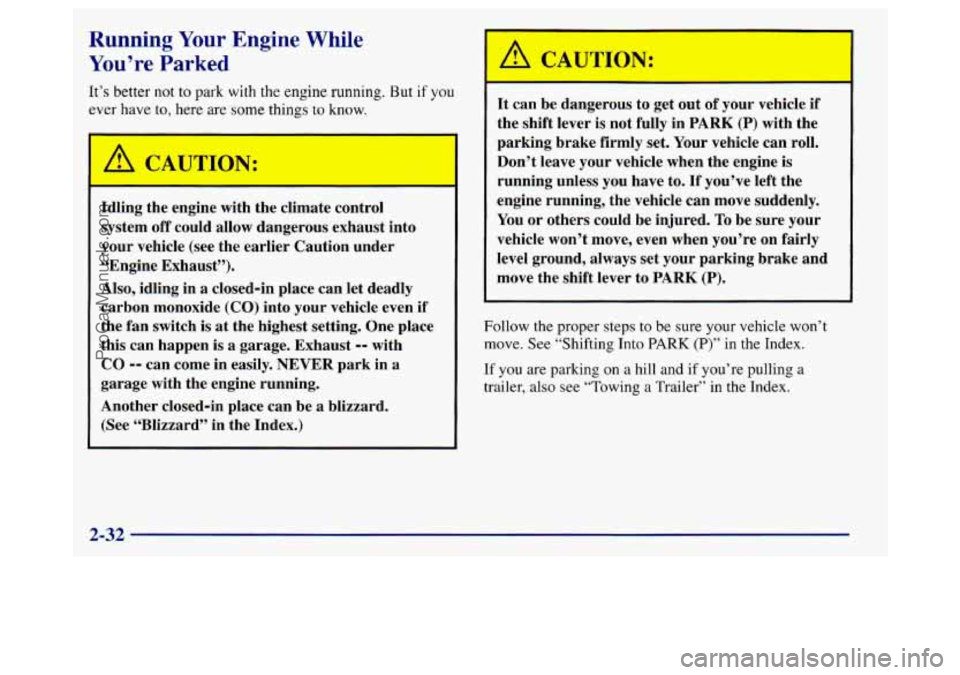
Running Your Engine While
You’re Parked
It’s better not to park with the engine running. But if you
ever have to, here are
some things to know.
Idling the engine with the climate control
system off could allow dangerous exhaust into
your vehicle (see the earlier Caution under
“Engine Exhaust”).
Also, idling in a closed-in place can let deadly
carbon monoxide
(CO) into your vehicle even if
the fan switch is
at the highest setting. One place
this can happen is
a garage. Exhaust -- with
CO -- can come in easily. NEVER park in a
garage with the engine running.
Another closed-in place can be a blizzard. (See “Blizzard” in the Index.)
I
It can be dangerous to get out of your vehicle if
the shift lever is not fully in PARK
(P) with the
parking brake firmly set. Your vehicle can roll.
Don’t leave your vehicle when the engine is
running unless you have to. If you’ve left the
engine running, the vehicle can move suddenly.
You or others could be injured.
To be sure your
vehicle won’t move, even when you’re on fairly
level ground, always set your parking brake and
move the shift lever to
PARK (P).
Follow the proper steps to be sure your vehicle won’t
move. See “Shifting
Tnto PARK (P)” in the Index.
If you are parking on a hill and if you’re pulling a
trailer, also see “Towing
a Trailer” in the Index.
2-32
ProCarManuals.com
Page 116 of 388
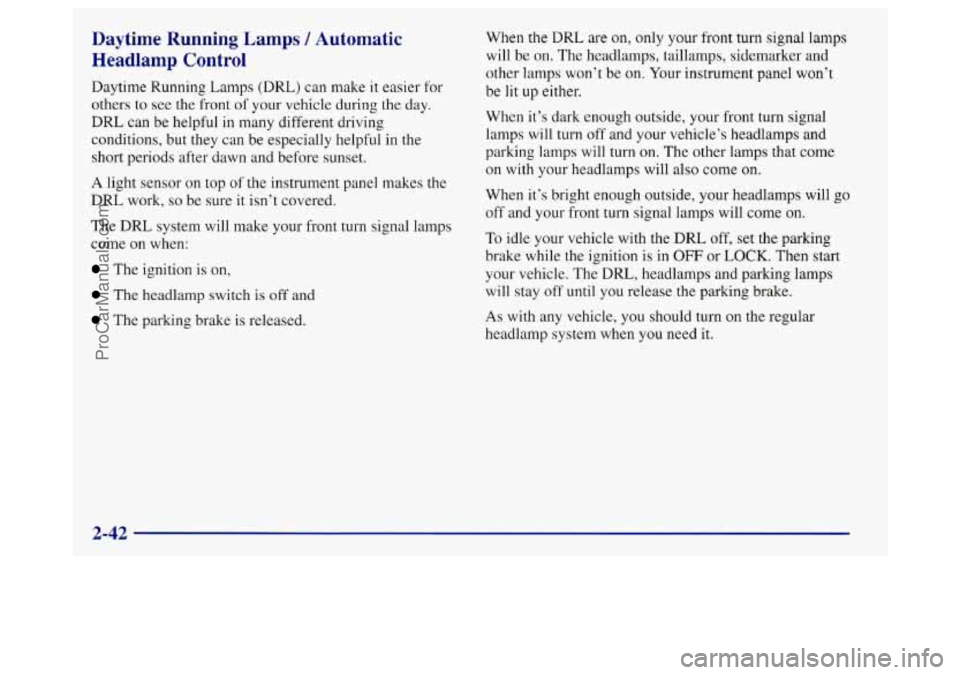
Daytime Running Lamps / Automatic
Headlamp Control
Daytime Running Lamps (DRL) can make it easier for
others to see the front of your vehicle during the day.
DRL can be helpful in many different driving
conditions, but they can be especially helpful in the
short periods after dawn and before sunset.
A light sensor on top of the instrument panel makes the
DRL work,
so be sure it isn’t covered.
The DRL system will make your front turn signal lamps
come on when:
The ignition is on,
The headlamp switch is off and
The parking brake is released. When
the DRL are on, only your front turn signal lamps
will be
on. The headlamps, taillamps, sidemarker and
other lamps
won’t be on. Your instrument panel won’t
be lit up either.
When it’s dark enough outside, your front turn signal
lamps
will turn off and your vehicle’s headlamps and
parking lamps will turn on.
The other lamps that come
on with your headlamps will also come on.
When it’s bright enough outside, your headlamps will
go
off and your front turn signal lamps will come on.
To idle your vehicle with the DRL off, set the parking
brake while the ignition
is in OFF or LOCK. Then start
your vehicle. The
DRL, headlamps and parking lamps
will stay
off until you release the parking brake.
As with any vehicle, you should turn on the regular
headlamp system when you need it.
ProCarManuals.com
Page 135 of 388
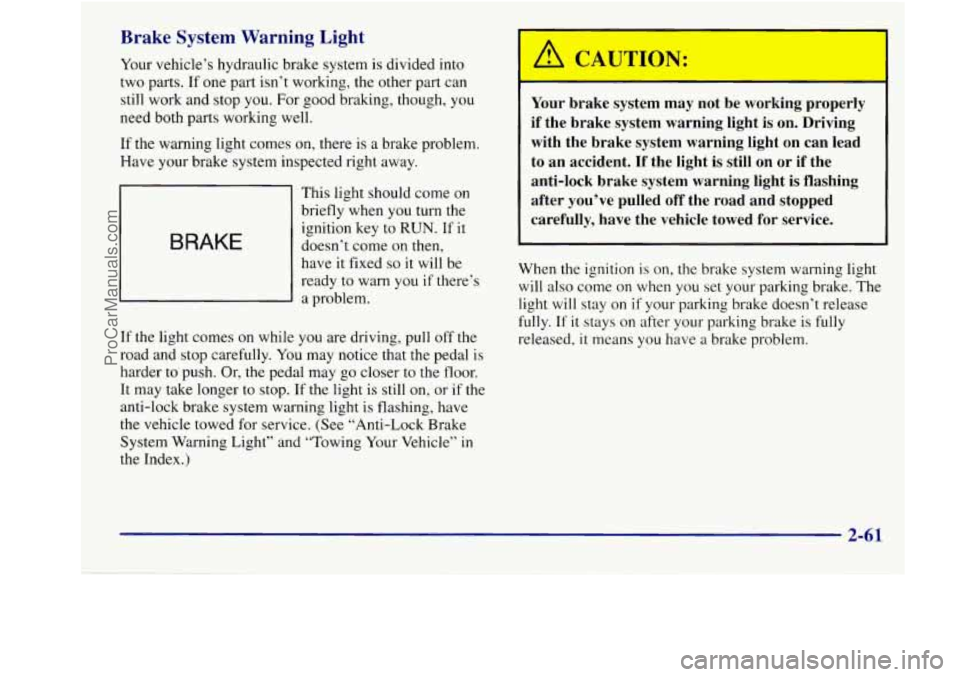
Brake System Warning Light
Your vehicle’s hydraulic brake system is divided into
two parts. If one part isn’t working, the other
part can
still work and stop you. For good braking, though, you
need both parts working well.
If the warning light comes on, there is a brake problem.
Have your brake system inspected right away.
BRAKE
This light should come on
briefly when you turn the
ignition key to
RUN. If it
doesn’t come on then,
have it fixed
so it will be
ready to warn
you if there’s
a problem.
If the light comes on while you are driving, pull off the
road and stop carefully. You may notice that
the pedal is
harder
to push. Or, the pedal may go closer to the floor.
It may take longer to stop. If the light is still on, or if the
anti-lock brake system warning light is flashing, have
the vehicle towed for service. (See “Anti-Lock Brake
System Warning Light” and “Towing Your Vehicle” in
the Index.)
Your brake system may not be working properly
if the brake system warning light is on. Driving
with the brake system warning light
on can lead
to an accident. If the light
is still on or if the
anti-lock brake system warning light is flashing
after you’ve pulled off the road and stopped
carefully, have the vehicle towed for service.
When the ignition is on, the brake system warning light
will also come on when you set your parking brake. The
light will stay on if your parking brake doesn’t release
fully. If it stays on after your parking brake is fully
released, it means you have
a brake problem.
2-61
ProCarManuals.com
Page 196 of 388
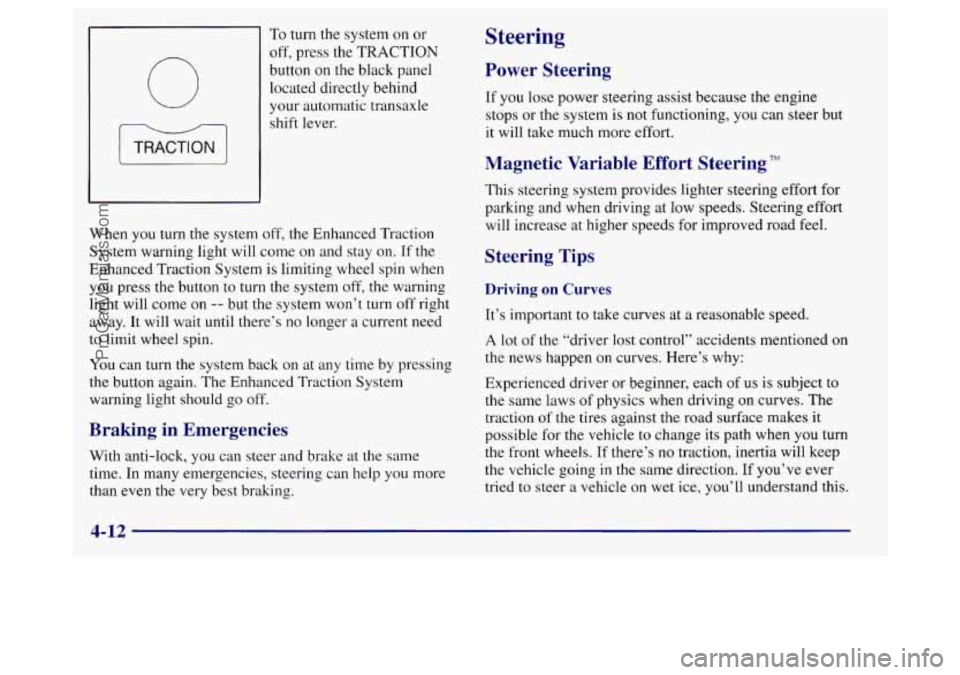
To turn the system on or
off, press the TRACTION
button on the black panel located directly behind
your automatic transaxle
shift lever.
When
you turn the system off, the Enhanced Traction
System warning light will come on and stay on. If the
Enhanced Traction System is limiting wheel spin when
you press the button to turn the system off, the warning
light will come on
-- but the system won’t turn off right
away. It will wait until there’s no longer a current need
to limit wheel spin.
You can turn the system back on at any time by pressing
the button again. The Enhanced Traction System
warning light should go off.
Braking in Emergencies
With anti-lock, you can steer and brake at the same
time. In many emergencies, steering can help you more
than even
the very best braking.
Steering
Power Steering
If you lose power steering assist because the engine
stops or the system
is not functioning, you can steer but
it will take much more effort.
Magnetic Variable Effort Steering TM
This steering system provides lighter steering effort for
parking and when driving at low speeds. Steering effort
will increase at higher speeds for improved road feel.
Steering Tips
Driving on Curves
It’s important to take curves at a reasonable speed.
A lot of the “driver lost control’’ accidents mentioned on
the news happen on curves. Here’s why:
Experienced driver or beginner, each
of us is subject to
the same laws of physics when driving on curves. The
traction
of the tires against the road surface makes it
possible for the vehicle
to change its path when you turn
the front wheels.
If there’s no traction, inertia will keep
the vehicle going
in the same direction. If you’ve ever
tried to steer a vehicle on wet ice, you’ll understand this.
4-12
ProCarManuals.com